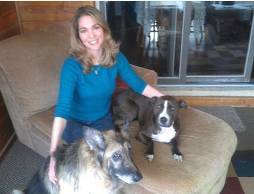
Dana Dietrich, DVM
Emergency Veterinarian
Dogs and cats that go blind can, with time, adjust to their surroundings through use of their other senses. It is important to remember that each animal is an individual and therefore the amount of time it will take for this adjustment to occur will vary from pet to pet. The key is to be patient and calm. It will help your pet immensely to know that you and your family are there to help them through the adjustment period.
Learning that your pet has gone blind can be a stressful period for both owner and pet. In many cases, this period can be harder on the owner than the pet. Your pet can sense your emotional state, so treating your pet the same as you did before their blindness is important in helping them through the adjustment period. One of the keys to helping a pet adjust to their loss of sight is to make them feel as secure as possible at all times. An animal that feels secure will be less stressed and more apt to adjust quicker. This can be accomplished in several ways and the following suggestions are meant as a guide to help owners begin the adjustment process.
Cats should be kept indoors.
Try not to move furniture or alter lawns or gardens. Your pet will eventually learn where things are and will avoid bumping into them.
When going for walks, use of a harness instead of a neck collar will give you a greater ability to guide your dog as you walk and help them to avoid bumping into things.
Leave your pet’s food and water in the same place at all times.
Give your pet lots of praise and encouragement as they learn how to navigate without the use of their eyesight, but don’t “kill with kindness”. Do not baby them. They will have to learn eventually how to get around on their own.
*Safety
Let visitors know that your pet is blind. Encourage others to be diligent about keeping outside doors shut and to watch their step around your pet, especially if they are still in the adjustment phase.
Child gates are great for keeping pets out of areas where they can get into trouble. This may include areas with stairs or cluttered areas, such as a baby’s play room.
Inside the home, look for things that can be tripped over, that may poke the animal in the eye, or can fall on the pet if bumped into. Make adjustments accordingly to help aid your pet during their transition period.
Outside of the home, look for things similar to those you would look for inside. Be aware of low hanging tree branches and bushes that your dog can be poked by or become tangled in. Trim these areas as needed.
It is NOT recommended to let a blind dog off lead at any time while outside unless it is inside a fenced in, secure area. Even the most obedient dog who has never wandered away from home can run into problems such as wildlife, other pets, and automobiles. If you choose to allow your dog off lead in a fenced in area, it is recommended that the dog still be supervised. Also, check the fence frequently to make sure there are no “escape routes” for your dog and inspect the area for things, such as fallen tree branches, in order to avoid injury.
*Other helpful hints
Games can be adapted for the blind pet. Try toys that make noise or ones you can put food in. Pets will learn to adapt to these games through use of their other senses, such as smell.
A clock with a different sounding “tick” in each room can help a pet differentiate which room of the house he is in.
Animals that go blind can adjust to their environment and still have a good quality of life. Using these steps as a guide can help make your pet feel secure during the adjustment period. This will help immensely and allow them to adjust quicker. If you have any questions, further information about caring for blind pets can be provided by your family veterinarian.
Reference: Petra Lackner, DVM, DAVCO
Information provided by Dr. Dana Dietrich. Dr. Dietrich is an emergency clinician at Aspen Meadow Veterinary Specialists. AMVS is a 24-hour veterinary facility providing specialty internal medicine, surgery, neurology, oncology, emergency and critical care, physical rehabilitation, and blood bank services for pets. They are located in Longmont at 104 S. Main St. For more information, go to www.AspenMeadowVet.com
 Print This Post
Print This Post







